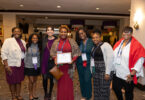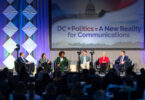Last year, I had the privilege of serving as PRSA Chair. I was the first, second-generation public relations counselor to serve as Chair and, from what I’ve been told, the youngest, as well. My tenure – like those of most leaders – was filled with challenges and opportunities that required a great deal of my time and attention. Still, chairing the Society was one of the greatest personal and professional experiences of my life; I’m a stronger leader, manager, communicator, counselor and person for it.
As PRSA embarks on the process of nominating its next slate of Directors, I would urge all members to consider serving the society and the profession in this role.
I’m honored to have served alongside a host of great leaders and past chairs; privileged to have partnered with our President and COO Bill Murray; and proud to have collaborated with PRSA’s skilled staff of dedicated professionals. Each made me stronger, but my most important job was allowing them to do theirs.
One of the most rewarding aspects of my Chairmanship was traveling around to meet public relations professionals in small towns and big cities, as a representative of the profession that I’ve been connected with since my first breath. Each person I met or worked with as Chair taught me something — far more than can be summarized here — but I thought I would share ten key learnings.
10. Contrary to what some may believe, major cities do not hold a monopoly on public relations know-how. There is outstanding public relations talent all over this country. Companies and clients are foolish to think otherwise.
9. Social media, while important, is not a communications panacea. Traditional media is evolving, and social media is here to stay; however, traditional media still represents a huge slice of the communication pie and wields tremendous influence. Had the traditional newspaper — inexpensive, informative, disposable and battery-free — been invented after the iPad, newsstand lines would be a common sight.
8. Today’s public relations students are wiser and better prepared than we were. My father was among the first to graduate from the first school of public relations, at Boston University; he was drawn to the profession because he heard it involved a lot of parties (true story). Today, just a generation later, there are more than 300 schools offering public relations majors. Here at the firm where I practice, I’m always amazed at just how bright our college interns are. Lookout world, here come some super-smart kids.
7. Worry over the number of journalists entering our field is misplaced. While I understand there are a number of qualified public relations professionals who are out of work, our profession benefits when smart, energetic and ethical people join our ranks. Journalists, however, need to understand that while many of their skills are transferable, public relations requires a unique set of talents and expertise. Journalists should be prepared to re-tool through the PRQuickStart and Accreditation in Public Relations (APR) programs.
6. Edward Bernays — often called “The Father of Public Relations” — was Sigmund Freud’s nephew. As a profession, we might benefit from Dr. Freud’s influence and rid ourselves of public relations’ Inferiority Complex. Our profession has come a long way, thanks to our commitment to education, accreditation, ethics, diversity and advocacy. That’s why a survey of chief marketing officers at major national and global advertisers conducted by the Association of National Advertisers found that the value public relations delivers as part of the overall marketing mix is increasing.
5. We need to update the definition of public relations, and quickly. Certainly, the 1982 definition continues to hold true — “Public relations helps an organization and its publics adapt mutually to each other.” This definition may speak to us, but not to those we serve. I also contend that public relations is a leadership (vs. management) function, as outlined in the official definition.
4. What’s in a title? At last year’s National Assembly, Delegates engaged in a spirited debate over our profession’s nomenclature; specifically, whether or not PRSA should open its membership to “communications professionals” other than public relations practitioners. Ultimately, the Assembly said no, but I believe PRSA should welcome all professional communicators who are willing to embrace our values and ethics. Still, those who practice our craft should proclaim themselves public relations professionals and avoid “flavor of the month” designations. To adopt a chant from the Penn State Nittany Lions, “WE ARE public relations.”
3. Ethics are vital to our profession’s long-term success. We serve as the antenna, conscience and voice of the organizations we represent. While many other communications disciplines utilize their antennas and voice, ours is the only one that serves as a conscience. We are the trust-builders and trust-keepers. Our commitment to ethics is essential not only to our professional success; the marketplace depends on it.
2. PRSA is essential to the long-term health and growth of public relations. Our Chapters (PRSA and PRSSA), Professional Interest Sections and advocacy program – including “The Business Case for Public
Relations(TM)” — are making a difference each day, while our diversity program is literally changing the face of the profession.
1. Everyday, I am proud and honored to be a part of this profession and of PRSA. I’m also grateful for the opportunity to have represented the profession and society as PRSA Chair.
Michael Cherenson, APR, is Immediate Past Chair of the Public Relations Society of America.







Great insights! Especially appreciate the points made in #10 and #4.